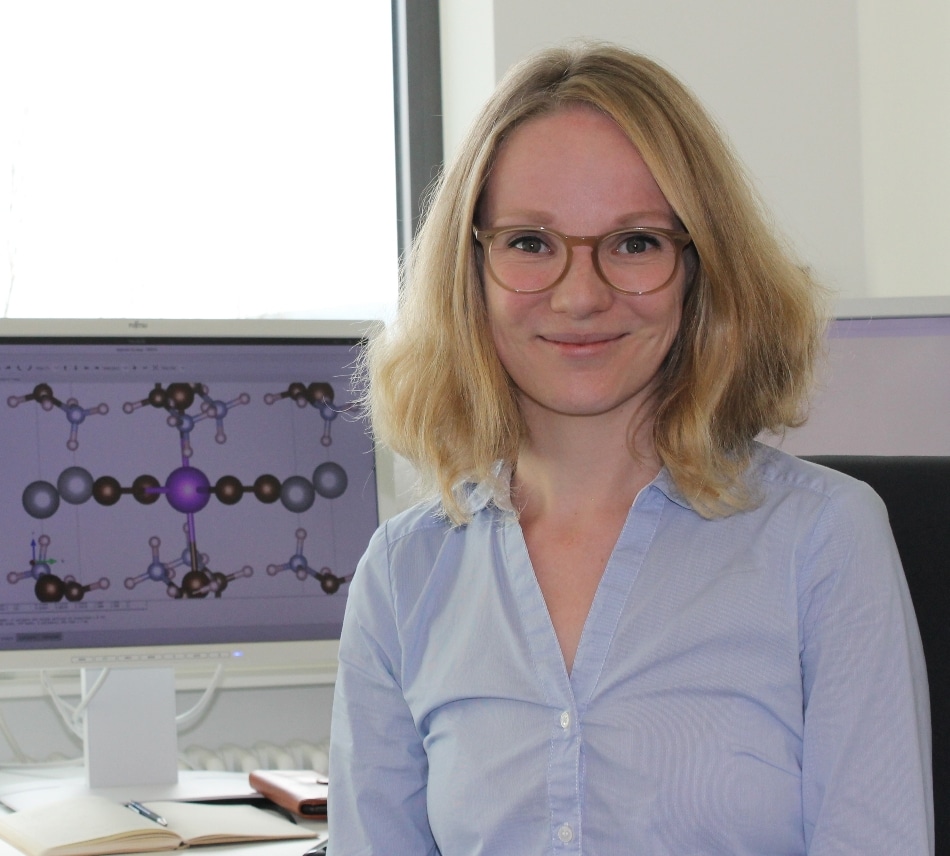Dec 14 2017
For her research on new solar cell materials, Dr. Linn Leppert (31), physicist in Bayreuth, has now received a research prize from the DFG research training group "Photophysics of Synthetic and Biological Multichromophoric Systems".
 Dr. Linn Leppert at her desk in Bayreuth. Her monitor displays a portion of a hybrid perovskite. Photo: Christian Wißler.
Dr. Linn Leppert at her desk in Bayreuth. Her monitor displays a portion of a hybrid perovskite. Photo: Christian Wißler.
The materials in question refer to hybrid halide perovskites with which a remarkably great level of efficiency can be attained when transforming light to electricity. Dr. Leppert uses quantum mechanical methods of density functional theory and many body perturbation theory in order to accurately calculate the electronic structure and dynamics of these greatly complex solid state materials.
From Berkeley back to Bayreuth
In his speech, Dr. Christian Laforsch, the University of Bayreuth's Vice President for Research & Junior Scholars Prof., stressed on the fact that the prizewinner "applied highly demanding theoretical methods to address issues with direct applications and in close proximity to the experiment." Dr. Linn Leppert performed much of her research as a postdoc at the Lawrence Berkeley National Laboratory in the US. For this, she was awarded a Feodor Lynen research grant by the Alexander von Humboldt Foundation.
She has been heading a project in Collaborative Research Centre 840 "From particulate nanosystems to mesotechnology" since her return to the University of Bayreuth. "We are trying to understand the electronic structure of familiar solar cell materials in order to derive principles for the design of new, energy-efficient materials. Many body perturbation theory is also indispensable for interdisciplinary research in this field at the intersection of physics and chemistry," Dr. Leppert explained.
Learning from biological systems
Commencing in January 2018, the University of Bayreuth will be heading a junior research group in the scope of the Elite Network of Bavaria (ENB). At the forefront include biological systems that employ photosynthesis in order to obtain chemical energy from sunlight. Purple bacteria are of specific interest. "We already know a lot about how these bacteria manage to absorb light energy via pigment molecules and transfer it to reaction centers where photosynthesis begins. However, most calculations in the past have been based on models that do not always do justice to the complexity of the physical processes. Quantum mechanical methods with which excitation energies can be calculated even in large pigment molecules are going to enable findings to be considerably more precise," said the award-winning physicist. She added, "On Bayreuth's campus, a very high-performance IT infrastructure is available for this substantial computation power."
Dr. Leppert is assertive that the anticipated results concerning both the absorption and utilization of light energy in nature – whether in plants or bacteria – will help in speeding up the development of greatly efficient solar cell materials: "These materials may display properties which are lacking in the silicon solar cells that are currently still in use. Learning from natural systems in order to develop artificial systems for collecting and utilizing renewable energy is an exciting vision."